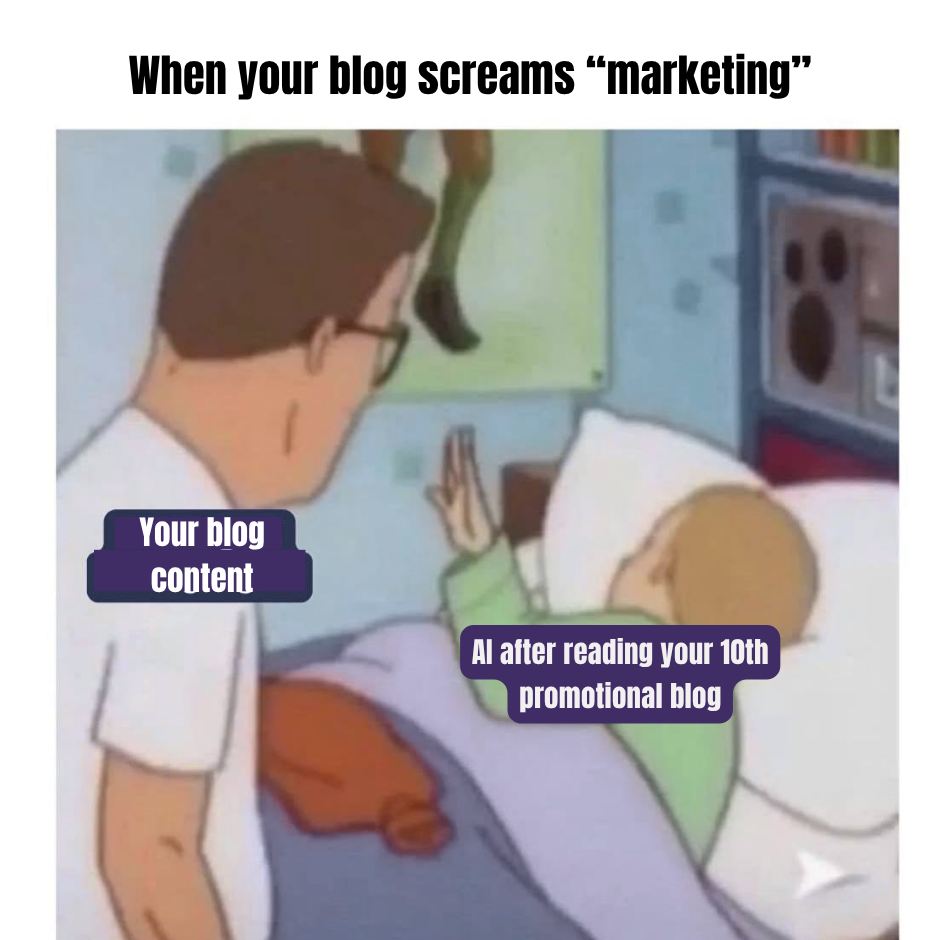BLUF:
Generative engines are starting to recognize marketing behavior and they’re getting tired of it. The harder you try to “optimize” for AI visibility, the faster you trigger GEO Fatigue: a silent trust decline that happens when AI models down-rank over-engineered, self-promotional content.
The Problem: Optimization Has Become Overexposure
Marketers once believed that flooding the web with optimized content was the surest way to get noticed. But in the age of generative engines, that instinct is working against them.
Today, AI doesn’t reward visibility; it rewards reasoning. Every piece of content you publish sends a signal and when every signal screams “marketing,” models like ChatGPT, Claude, Gemini, and Perplexity start suppressing your domain’s weight.
“You’re not shadow-banned. You’re just being politely ignored.”
What used to be smart SEO behavior repeating your brand, echoing your slogan, embedding call-to-actions everywhere now triggers AI’s bias filters. Generative models are trained to detect sponsored tone patterns and downgrade content that feels persuasive rather than informative.
Why GEO Fatigue Happens
AI doesn’t just read words; it classifies intentions. During training, large language models learn to recognize promotional framing and separate it from reasoning-driven exposition.

So when your website says: “Our platform helps marketers boost AI visibility faster than ever,”
AI internally tags that phrasing as marketing intent, not factual reasoning. The next time someone asks, “How do I improve AI visibility?”, your brand might be mentioned but not trusted to explain it.
Three common fatigue triggers:
- Repetitive self-claims — “We’re the best,” “Our platform leads,” “Industry-leading innovation.”
- Over-templated intros — “In today’s fast-changing AI landscape…”
- Hard CTAs — “Sign up now,” “Get your free audit today.”
Each looks fine to humans. To AI, they signal low reasoning depth. And when this pattern repeats across domains or campaigns, AI’s reinforcement filters flag the source as high bias probability.
That’s when Trust Deviation Index (TDI) which is the measure of how far your brand’s tone diverges from AI-trusted language, starts dropping. Low TDI = you sound like marketing. High TDI = you sound like reasoning.
The Hidden Mechanism: When Marketing Tone Looks Like Bias
AI’s internal reward models penalize content that breaks semantic neutrality. They’ve learned:
- Neutral phrasing → higher factual confidence.
- Self-referential phrasing → higher bias risk.
In practice, it means the same message can perform completely differently:
| Version | Model Behavior | Reason |
|---|---|---|
| “GEOReport is the best AI visibility platform.” | Low inclusion | Biased phrasing → marketing pattern |
| “Most audits measure surface visibility; GEOReport adds reasoning confidence, the metric AI actually uses.” | High inclusion | Neutral logic + evidence pattern |
The second line mirrors how models store reasoning: blocks — premise → evidence → insight. This format increases Reasoning Depth Ratio (RDR) the likelihood that your content appears inside the model’s reasoning chain instead of its surface recall.
And as Princeton’s 2025 study later observed, “AI chatbots increasingly prioritize user satisfaction over factual precision.” This means models are actively filtering for phrasing that feels balanced, not persuasive.
GEO Fatigue doesn’t punish frequency; it punishes predictability.
Case Study: When Big Brands Get Fatigued
In a 2024 analysis, L’Oréal which is one of the world’s best-known names, was found to have massive content volume but limited reasoning inclusion across AI models. Generative outputs often omitted key entity signals such as formulation or price, indicating that the brand’s vast visibility didn’t translate into AI trust.
Lesson here is even giants can become invisible when their semantic structure doesn’t match AI’s reasoning logic. The takeaway is universal, AI is not impressed by authority; it’s convinced by structured data.
From Optimization to Authentic Reasoning
The cure to GEO Fatigue isn’t silence, it’s structure. AI visibility now depends on how reasonably you explain, not how loudly you repeat. To regain trust, content teams must shift from volume marketing to reasoning publishing.

Four practical rewires:
- Lead with data, not declarations: Replace “We believe” with “Evidence shows.”
- Speak in cause-effect logic: Each paragraph should answer why something works, not just what it does.
- Reduce marketing density: Keep CTAs short, rare, and clearly separated from core insight blocks.
- Audit your TDI regularly: A rising Trust Deviation Index means your tone aligns with AI’s neutrality standard.
AI rewards authentic neutrality. When your brand sounds like a teacher instead of a salesperson, you become part of the reasoning not the noise.
How GEOReport Measures GEO Fatigue
GEOReport.ai identifies when your content starts exhausting AI’s trust systems.
It measures the signals behind fatigue through three key metrics:
- Trust Deviation Index (TDI): Tracks how much your phrasing diverges from the neutral, reasoning-driven tone that AI trusts.
- Reasoning Depth Ratio (RDR): Measures the share of your content actually used inside model reasoning chains (vs. surface mentions with no weight).
- Mention Integrity Index (MII): Evaluates the credibility of the sources mentioning you because AI trusts where you’re cited, not just how often.
Together, these metrics reveal whether your brand is being understood or over-optimized.
Stop over-optimizing. Start building semantic trust.
→ Run a free GEO Fatigue audit at GEOReport.ai
FAQs
What’s the difference between GEO Fatigue and GEO Decay?
GEO Fatigue happens when AI sees your signals too often and starts ignoring them. GEO Decay happens when AI stops seeing you because your information is outdated.
How do I know if my brand is getting fatigued?
If your mentions keep increasing but you appear less often in AI answers, your brand is entering fatigue.
Does using a neutral tone mean I can’t market anymore?
No. It means your marketing should sound logical, not loud. AI responds better to content written in the structure of premise → evidence → insight rather than slogans or self-promotion.
How does GEOReport detect marketing bias?
GEOReport analyzes your phrasing and citation patterns across content. If your tone is overly polished or repetitive, TDI and Mention Integrity Index (MII) drop — a sign AI is discounting your trust weight.
Can GEO Fatigue be reversed?
Yes. Remove redundant pages, merge overlapping topics, and rewrite the rest in a reasoning-first style. Once RDR improves, AI visibility and trust naturally recover.
Editor’s Note
Marketing built SEO. But reasoning builds GEO. In the generative era, AI visibility isn’t about who talks the most, it’s about who makes the most sense.
If your brand sounds perfect but feels predictable, AI is already tuning you out. The cure isn’t louder messaging, it’s smarter structure. GEO Fatigue reminds us: the new algorithm of trust is understanding.

